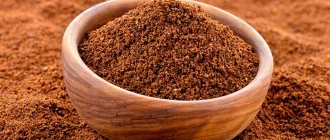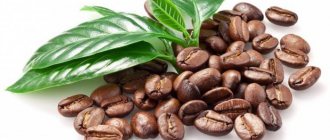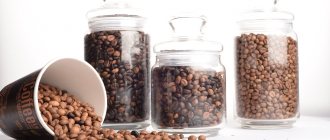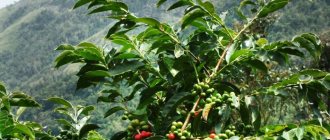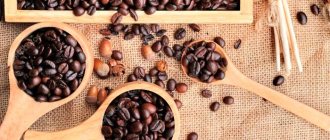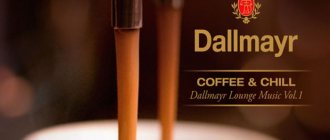It's no secret that coffee beans are roasted before they are ground, prepared in our favorite way and end up in our cup in the form of an excellent drink.
- Like any product that goes through a similar processing stage, coffee beans can be roasted to varying degrees. A simple example here would be a classic steak, which has several degrees of doneness. Steaks of different roasts have their own qualities and taste. And each, including “Well Done,” has its fans.
The same is true with coffee. Each degree of roasting gives the cup its own taste, filling it with unique characteristics inherent only to it. Much, of course, depends on the type of coffee, on the quality of the coffee beans, but if coffee roasting is done extremely poorly, it will “kill” any bean, even the best one.
Why do you need to roast coffee?
Raw coffee beans are dense green seeds consisting of approximately half carbohydrates in various forms and half a mixture of water, proteins, lipids, acids and alkaloids. Green coffee tastes and smells most like peas and is just as hard in texture.
It is not recommended to drink green coffee in its pure form, and those who say that you can lose weight with it are very mistaken; you can literally get “adventures on your ass”, but it is unlikely to lose weight. Therefore, green grain must be subjected to heat treatment in order to change the structure of the grain and its biochemistry during the roasting process.
Preparing coffee beans for roasting
First of all, green coffee must be washed to remove any dust and husks that may be present in the packaging of the beans. In principle, the husk is not an obstacle to frying, but the dust should be removed. Rinse with running water using a colander.
After washing, the green coffee beans should be dried by carefully laying them on a clean cloth and a flat surface in one layer. To speed up drying, you can use an ordinary hair dryer set to low air flow. Once the grain is dry, the roasting process can begin.
Is it possible to achieve the same quality with home roasting as with industrial roasting?
When roasting coffee beans, the smell and taste dormant in their depths are released, the taste and aroma that we are accustomed to associate with this wonderful drink. If you brew green coffee, i.e. unroasted, few would have realized that this drink was made from coffee beans, and most likely the cup would have been left unfinished.
Coffee can be roasted in different ways: there is no one correct way of roasting. After a little training, you can achieve quite acceptable results even with the most primitive means. Many people think that professional, industrial roasters somehow magically roast coffee better than small home roasters. This misconception is actively promoted by many in the coffee business.
The hoax is naturally to their advantage. The reality is that there is no difference. The difference between roasting in, say, a Gene roaster or I-roast, on the one hand, and roasting in an industrial roaster is only in productivity. On industrial equipment you can roast tens and hundreds of kilograms per hour, and on home roasters tens and hundreds of grams.
With all else being equal, and in the volumes that can be discussed when roasting coffee at home, no one will ever be able to determine by taste whether a well-prepared cup of coffee was made from beans roasted on the most expensive German Probat or, say, on homemade coffee roster In this sense, coffee roasting is still an individual creative process, where at home, having confidence in your theoretical knowledge and practical skills, it is quite possible to achieve the highest skill.
Roasting coffee beans is a mandatory process to ultimately obtain an aromatic and healthy drink.
Another thing is that deep knowledge about different types of coffee, how to maximally emphasize and identify their individual properties, how to create a balanced blend that is as good as possible and, moreover, fit into certain price limits, as from year to year when prices for raw materials change and the offer of available varieties maintaining the same taste of the blend - all this is possible only thanks to the experience accumulated over the years.
How does the strength of coffee depend on the degree of roasting?
Yes, in general, not at all if we are talking about the strength of the coffee in the cup. In general, the darker the coffee is roasted, the lower the caffeine content. For light roasting this figure is about 1.37%, for dark roasting – 1.31%. This is if we talk about the grain itself.
But when we talk about coffee in a cup, then everything depends on the amount of coffee prepared (that is, on the coffee/water ratio), on the size of its grind, on the chosen method of preparing the drink. The same coffee beans can end up being prepared in such a way that the strength of the finished drink will vary greatly.
That's probably all now. Enjoy your coffee!
Why do varieties of different origins have different tastes?
Some coffees have many flavors in common and can be grouped into categories, often given geographical names, such as Central American coffees. Now, it should be said, however, that these varieties are classified in the same taste category not because of geography. They are in the same category due to the fact that in these countries the botanical species of coffee trees are often the same, the climate is the same, the soil is the same, and the technology for primary processing of the fruit is the same.
Agriculture is a very conservative industry and therefore local traditions and habits play a large role. In Yemen, coffee undergoes what is called dry processing. This is a tradition that is passed down from generation to generation, but it also has its own natural explanation. There is a water shortage in Yemen.
In Central America, where water is not a scarce commodity, farmers have adjusted to this, and there coffee is wet processed. The idea of a Yemeni farmer on the one hand and a Costa Rican farmer's idea of how to grow coffee are different. The available technologies are also different, therefore the end result will also be different. With careful processing, both wet and dry methods give excellent results; if the technology is violated, taste defects will appear in both cases.
Each type of coffee, however, has its own individual set of taste characteristics, which is unique to it. After all, there are countless botanical varieties of the coffee tree, the soil is different everywhere, the climate and processing technologies are very different. The science and practice of specialty coffee is based on the awareness of this diversity.
History page
As you know, coffee was discovered many centuries ago. Historians have found the first mentions of this product in letters dating back to the 15th century. However, it was not until 1800 that the production of the ground product began. We owe this event to Mr. Bovey and his company in San Francisco called Pioneer Steam Coffee & Spice Mill. It was there that the first batches began to be produced, but then they were produced in tin cans. It was only in the 1900s that vacuum packaging technology began to be used for this product. It has been proven that thanks to it, the usual aroma and taste are preserved. It was then that people began to brew ground coffee much more often. And this is not surprising. After all, now there was no need to purchase a coffee grinder, and besides, the preparation time was reduced.
General recommendations
Before moving directly to practice, we advise you to adopt some theoretical points that will save you from annoying mistakes and allow you to achieve the most correct roasting:
- Before frying, be sure to open the window or turn on the hood. The process is accompanied by a large amount of smoke.
- There are different degrees of roasting of grain. So, with a light roast (the beans become light or light brown), you are unlikely to achieve the desired “coffee” taste. The usual taste is obtained with medium and dark roasting. The advantage of roasting yourself is that you can experiment to your heart's content, choosing the ideal degree of roasting of the beans to suit your taste.
- Each type of grain requires special conditions under which their true taste and aroma are fully revealed. Professionals know exactly how to approach this or that variety, what combinations will be the most successful.
- The real roasting begins after the “first crack,” when the oils come out and the sugars in the bean caramelize.
- When roasting at home, you need to constantly stir the grains. This is a rather lengthy and responsible process, and if you take a break, you can forget about delicious coffee.
- After roasting, the grains need to be cooled by first pouring them onto a flat surface in an even layer. A regular fan will also work for cooling. It is not recommended to leave the beans to heat in a frying pan or in the oven after turning off the heat, since there is still a risk of overcooking the coffee and not getting the result you expected.
During the home roasting process, the husk remains. When using professional equipment, it is blown out. The husk does not affect the taste of the drink. To get rid of it, just pour the grains into a colander.
The taste of the drink depends on the degree of roasting of the coffee beans.
And, most importantly, at least 6-12 hours must pass before grinding the coffee beans and preparing the drink. Many who have roasted beans at home have complained about the unsatisfactory taste of the drink, which is most often due to the fact that the beans were cooked immediately after they were roasted.
Features of making Turkish coffee
This method has been known since the 16th century. Making coffee in a Turkish coffee pot has a number of advantages, most of which are due to the special shape of the container. The classic cezve is made in the shape of a cone, which allows you to fully reveal the taste and aroma of ground grains with the formation of thick foam.
You can prepare ground coffee in a Turk, both from copper and ceramics, in the following order:
- Grind the beans in a burr coffee grinder. Only in this case can you achieve perfect grinding (almost like flour). To prepare a strong drink, you need to take 10 g of coffee per 100 ml of water.
- Pour the required amount of ground grains and 10 g of sugar into the Turk.
- Pour 100 ml of water. In this case, the contents of the Turk do not need to be mixed.
- Place the cezve on low heat.
- Heat the contents of the Turk until the foam rises to the edges, then remove it from the heat. It is important not to miss this moment so that the coffee does not spill out of the cezve.
- Wait until the foam settles, then return the Turk to the fire again. Repeat the same action 3 times.
- Wait 2 minutes for the drink to brew and pour it into cups.
Roast types
It is important to remember that the final taste and aroma properties of coffee are influenced by other factors besides roasting: the type and age of the beans, the region of their cultivation, storage method, etc.
During the roasting process, the chlorogenic acid contained in coffee decomposes into quinic and caffeic acid, and bitter chlorogenic acid lactones are simultaneously formed. During intense roasting, lactones decompose, resulting in the quintessence of bitterness - phenylindanes. Therefore, the more the coffee is roasted, the more intense the bitterness.
| Roasting degree | Temperature | Appearance of grains | Taste and aroma |
| Cinnamon Roast | +195 °C | Dry, light brown | Delicate, with the aroma of freshly baked bread and pronounced sourness |
| New England Roast, Light | +205 °C | Dry, slightly darker than in the previous case | There is still sourness, but without bread notes |
| American Roast | +210 °C | Dry, rich light brown color | Sourness combines with delicate bittersweet notes |
| City Roast | +220 °C | Dry, rich brown color | Bittersweet notes are felt more clearly, the sourness weakens. This roast is good for coffee tastings |
| Full City Roast | +225 °C | Rich brown color, with the first drops of oil on the surface | Shades of chocolate and caramel appear in the taste |
| Vienna Roast | +230 °C | Surface oily, color dark brown | The sourness disappears, the caramel tones become more intense |
| French Roast | +240 °C | Color – dark brown, more oil on the surface | Burnt tones are woven into caramel shades, and astringency appears. This roast is considered optimal for making espresso. |
| Italian Roast | +245 °C | The color is getting darker, there is more oil | The bitterness is felt more and more clearly. Roast suitable for espresso |
| Spanish Roast | +250 °C | Brown-black color, oily surface | Sharp bitter taste with notes of burnt coffee. Not all varieties can withstand this degree of roasting: some grains simply become charred. |
Cereal, ground or instant – the benefits of each type
An important advantage of coffee beans is the ability to visually assess appearance and freshness, and therefore correspond to a considerable cost. In addition, whole grains retain flavor longer.
When declaring on the label that blends contain 100% Arabica coffee, manufacturers are often disingenuous. The cost of coffee is often reduced by “diluting” the finicky, and therefore expensive, Arabica beans with less valuable Robusta varieties.
How to choose the right coffee in accordance with the stated label and considerable cost?
- Externally, Arabica beans resemble oval beans with a wavy longitudinal line. Their size is 6-8 mm (Yemenite varieties are slightly smaller).
- Robusta grain is a small round pea with a straight longitudinal line.
- Fresh grains of both types are velvety to the touch, without bitterness in the aroma.
- Too small, uneven surface, porous grains indicate a low-quality product.
- Different colors of beans in the package indicate different degrees of roasting (as in the Melange mixture).
If the choice fell on ground coffee, you should think in advance about the method of brewing the drink and decide on the degree of grinding:
- Coffee ground almost into flour is good for brewing in cezves and espresso coffee makers.
- Preparing the drink in a filter coffee maker requires fine grinding for 20 seconds.
- Universal grinding takes less time - 13-14 seconds, suitable for all types of coffee makers and cezves.
- The size of coffee particles during coarse short grinding (≈10 sec.) reaches 0.8 mm - ideal for piston coffee makers.
Methods used
The following are the effective and most commonly used methods for roasting coffee at home.
On a frying pan
This is a classic method with a large number of fans. Such preparation will not take much time.
Step-by-step instruction:
- It is recommended to roast coffee in a cast iron frying pan. It has a thick bottom, so heating will occur evenly. It is important to clean the container thoroughly first. It should not smell of anything - third-party odors will mix with the aroma of Arabica, this will spoil the taste of the drink. Also thoroughly clean the wooden spatula with which you will stir the fruit.
- It would be useful to prepare the surface on which the raw materials will be cooled. At home, it is better to use a metal baking tray.
- The beans should be thoroughly washed under running water. This is required to remove any husks that may interfere with frying. Washing is also necessary to get rid of dust that can clog the mill.
- Wait for the grains to dry.
- Open all the windows in the house and turn on the hood. This is necessary to prevent the rich coffee smell from spreading throughout the house. It will be difficult to weather it.
- Heat a frying pan and pour the beans into it. In the first 2 minutes, the room where the roasting process takes place will be very smoky.
- The grains should be fried to the desired state. Stir them constantly. The minimum simmering time is 4 minutes.
- Remove container from heat. Place the beans on a baking sheet and place them in a cool place to cool.
Roasting coffee beans in a frying pan is the most common method of preparing raw materials for an aromatic drink.
Hairdryer
The device that women use to style and dry their hair is not suitable for roasting coffee. You need to take a hair dryer. This technique is recommended for use when preparing Robusta beans.
Instructions:
- Take an enamel pan with a thick bottom. It must be perfectly clean.
- Place a colander or sieve on top of it. Add beans.
- First, they are fried with a hairdryer turned on at medium power. Heat the grains well, stirring them constantly.
- The minimum processing time is 2 minutes.
- Then switch the device to maximum power. As you stir vigorously, you will see the husks fly off the beans. Gradually they will darken.
- The average roasting time is 8-10 minutes.
- After turning off the hair dryer, stir the raw material for about 1 minute.
In the oven Before you begin the process of roasting coffee beans, you need to carry out several preparatory processes:
- Wash the baking tray well to eliminate any foreign odors that may affect the quality of the aromatic drink.
- rinse and dry the peeled coffee beans (the beans can be air dried naturally or wiped well with a towel);
- preheat the oven to maximum operating temperature (200-250°C)
- Place coffee beans in an even layer on a baking sheet.
Next, the baking sheet is placed in the oven for 13-15 minutes. The optimal internal temperature of coffee beans during roasting is 220 °C. Roasting of beans should be completed immediately after smoke and a characteristic crackling sound appear above the beans. This indicates that the coffee bean has reached the required internal temperature and indicates that the coffee is well roasted.
For high-quality roasting and giving the coffee beans a characteristic color, you need to open the oven after 15 minutes and stir and turn the beans for 5 minutes. Next, the grains are poured into a colander, shaking it regularly for 5-7 minutes. In this way, the roasted grains will quickly ventilate and cool.
A rapid cooling process is required for the coffee bean to stop the internal melting process. To speed up the cooling process, place a colander with coffee beans in the freezer. The cooling time is 15–20 minutes. Now coffee beans can be ground and brewed to produce an aromatic, invigorating drink.
Important! Coffee beans should be roasted in small batches, since after two weeks the ready-to-drink product loses its flavor and aroma.
In the microwave
We live in times of technological progress, and today practically nothing is impossible. For example, until recently no one thought about how to roast coffee beans in the microwave. Many were aware of how to roast coffee at home in the oven, but coffee in the microwave with foam is really something new. Now everything has changed. And we will try to share with you how to roast coffee beans in this miracle of technology.
Properly roasted coffee beans make a wonderful invigorating drink.
In fact, everything is very simple: you pour coffee onto a plate (not metal) and leave it on for 3-4 minutes at maximum power. The only thing is that you need to constantly and carefully monitor the entire procedure, because the coffee can burn. This is very troublesome and requires constant stopping of the process. But some people even like it.
In the bread maker
Before pouring green coffee into the bread maker, it is preheated to 120 degrees. After pouring coffee into the bucket, turn on a separate timer. The bucket is covered with a metal mesh to prevent the husks from scattering. The program is selected based on the cooking time. For example, a 14-minute program for kneading dough is ideal. Pros: the beans are roasted evenly, you can control the temperature. Cons: It's hard to hear crack over the noise of electrical appliances.
Roasters
The key to success is controlling the roasting temperature. Most home roasters come with a dedicated control panel, and some even allow you to program the temperature curve so you can replicate the same roasting parameters over and over again. In addition to them, special temperature sensors are also used, which, as a rule, read information about the temperature of the inner metal surface of the drum or the air supplied to it.
How many types of coffee are there?
This data provides insight into how the roaster is warming up, but it will only be relatively reliable if the roaster also has data on the temperature of the bean itself. Most roasters are not equipped with such sensors, so you should purchase a special electronic temperature sensor and install it in the drum.
You can connect the USB sensor to your computer or smartphone, allowing you to use great mobile apps that record data about your specific roast. Setting up such a miniature roasting shop at home is surprisingly easy and inexpensive, and you can safely experiment with different roasting styles and control the entire process yourself.
If you choose where to install the roaster, first of all you need to figure out where the hood will be located. If you roast coffee indoors, it is better to install the roaster under the kitchen hood or at least near an open window. The roasting process is accompanied by a lot of smoke, even if it is a quick roast. Of course, the ideal option is to roast your coffee outside: this can solve the problem of smoke, and for those who live in cold climates, it also simplifies the task of cooling the coffee after roasting.
Home roasters can be extremely sensitive to the amount of grain they feed. Too little coffee results in the coffee not roasting properly (as with deep frying, the bean ends up raw inside), while too much coffee slows down the roasting process, which can ultimately affect the taste of the coffee. It will take on a sooty taste and become slightly woody.
You should also look in advance at where production waste will accumulate and how the roaster is cleaned of it. If you do not clear the roaster of excess husk in time, it will make it difficult to blow the grain and, in addition, the risk of fire inside the roaster will increase. Finally, it is important to never leave the roaster unattended.
Important! Manufacturers take fire safety issues very seriously, and roasting coffee at home should be approached no less responsibly.
How to brew coffee in the microwave?
There are many different ways to prepare ground coffee. In the microwave is one of them. The main advantage of this method is the high cooking speed. However, in terms of taste, coffee brewed in a microwave is much inferior to that prepared in a Turkish coffee pot or coffee maker. But it is worth noting that people who are open to experimentation will also be interested in this method.
The sequence of actions during the preparation process will be as follows:
- Prepare a transparent cup made of special glass. Put ground coffee in it at the rate of 3 teaspoons per 200 ml of liquid
- Fill the cup with water to 2/3 of its volume and place it in the microwave.
- Set the power to maximum value.
- Watch the cup carefully in the microwave. As soon as foam begins to rise above the surface of the liquid, the microwave must be turned off.
- Leave the cup in the microwave for 2-3 minutes. During this time, the coffee will brew better and the grounds will sink to the bottom.
Cooling roasted coffee
The coffee roasting process is completed by cooling the coffee beans. If they are not cooled and left in a frying pan or in a pot, they will “burn”, i.e. The roast will come out darker than expected.
Roasted coffee must be cooled quickly enough to register the degree of roast to which the coffee beans reach in the pan. To do this, coffee is quickly poured onto a flat surface in a layer of one grain. The distance between the grains should also be 1-2 grains in size. You can use a fan for ventilation. With the amount of coffee that is roasted at home, this will not be a problem.
After cooling the roasted coffee beans, they must be packaged in an appropriate container and wait 10-15 hours. During this time, various physical and chemical processes continue in the coffee beans. Some substances break down and new compounds are formed, thanks to which the coffee drink will have a number of remarkable properties.
It is recommended to store roasted grains in glass containers
It should be noted here that the properties of different types and varieties of coffee can differ greatly from each other. This is explained by the composition of the soils in which the coffee grew and the degree of roasting. Therefore, often some people like strictly certain types of coffee, some people like certain mixtures, and some people may experience high blood pressure or depression from certain types of coffee. And, therefore, coffee is such an interesting product that needs to be selected individually for everyone.
French press for making coffee
It’s not difficult to brew an invigorating drink using a French press. Visually, a French press is a special closed container with a piston. To prepare a drink using this device, coarse coffee beans are required. Otherwise, it will be more difficult to push the piston with the filter. But grinding does not affect the taste of the drink. In any case, the coffee will be excellent.
The cooking process consists of the following steps:
- Boil water in a kettle, then let it cool slightly to a temperature of 90-95 °C.
- Pour ground coffee into a French press at the rate of 7 g per 100 ml of liquid.
- Pour a small amount of water (about 100 ml) into the container and stir the coffee with a spoon.
- Wait exactly 1 minute, then pour the remaining water into the French press.
- Close the container with a lid. Wait another 3 minutes.
- Carefully lower the piston all the way. Pour the drink into preheated cups.
